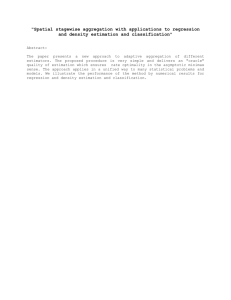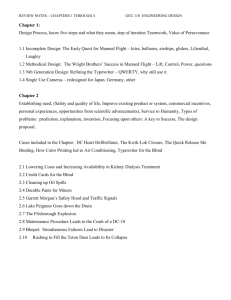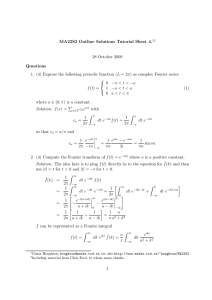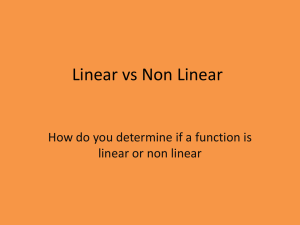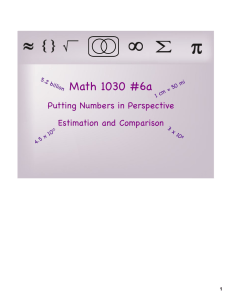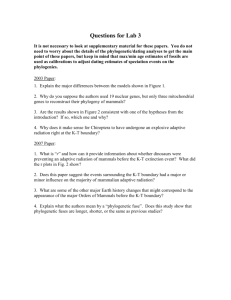ESTIMATING A GENERALIZED GORDON-SCHAEFER MODEL WITH HETEROGENEOUS FISHING DATA
advertisement
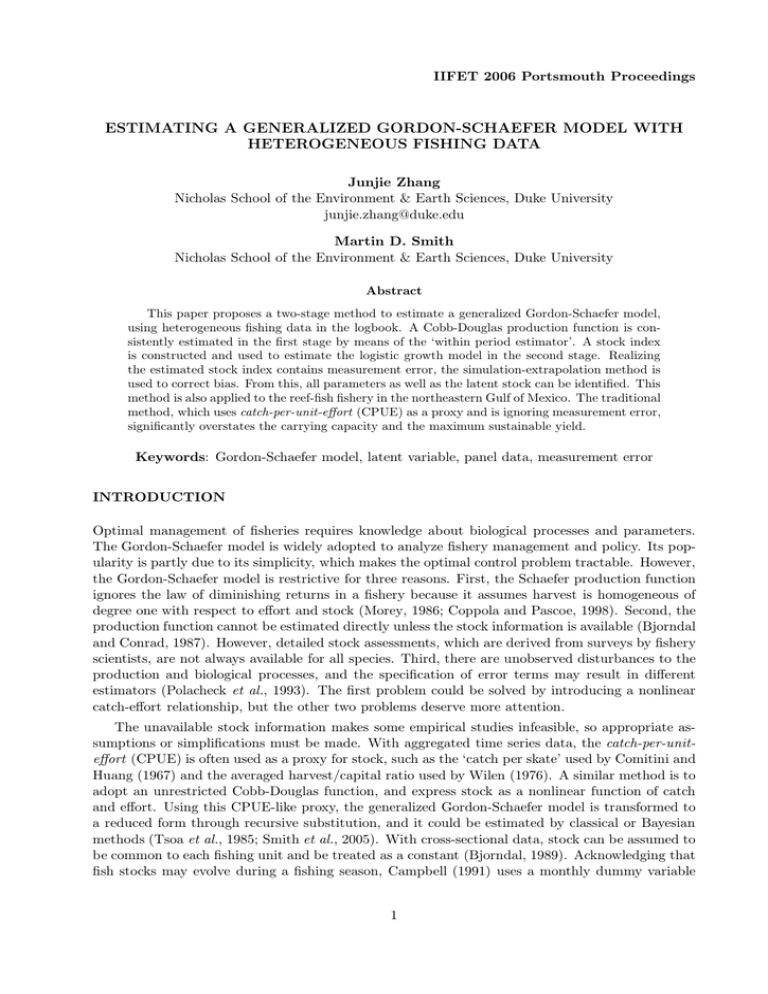
IIFET 2006 Portsmouth Proceedings
ESTIMATING A GENERALIZED GORDON-SCHAEFER MODEL WITH
HETEROGENEOUS FISHING DATA
Junjie Zhang
Nicholas School of the Environment & Earth Sciences, Duke University
junjie.zhang@duke.edu
Martin D. Smith
Nicholas School of the Environment & Earth Sciences, Duke University
Abstract
This paper proposes a two-stage method to estimate a generalized Gordon-Schaefer model,
using heterogeneous fishing data in the logbook. A Cobb-Douglas production function is consistently estimated in the first stage by means of the ‘within period estimator’. A stock index
is constructed and used to estimate the logistic growth model in the second stage. Realizing
the estimated stock index contains measurement error, the simulation-extrapolation method is
used to correct bias. From this, all parameters as well as the latent stock can be identified. This
method is also applied to the reef-fish fishery in the northeastern Gulf of Mexico. The traditional
method, which uses catch-per-unit-effort (CPUE) as a proxy and is ignoring measurement error,
significantly overstates the carrying capacity and the maximum sustainable yield.
Keywords: Gordon-Schaefer model, latent variable, panel data, measurement error
INTRODUCTION
Optimal management of fisheries requires knowledge about biological processes and parameters.
The Gordon-Schaefer model is widely adopted to analyze fishery management and policy. Its popularity is partly due to its simplicity, which makes the optimal control problem tractable. However,
the Gordon-Schaefer model is restrictive for three reasons. First, the Schaefer production function
ignores the law of diminishing returns in a fishery because it assumes harvest is homogeneous of
degree one with respect to effort and stock (Morey, 1986; Coppola and Pascoe, 1998). Second, the
production function cannot be estimated directly unless the stock information is available (Bjorndal
and Conrad, 1987). However, detailed stock assessments, which are derived from surveys by fishery
scientists, are not always available for all species. Third, there are unobserved disturbances to the
production and biological processes, and the specification of error terms may result in different
estimators (Polacheck et al., 1993). The first problem could be solved by introducing a nonlinear
catch-effort relationship, but the other two problems deserve more attention.
The unavailable stock information makes some empirical studies infeasible, so appropriate assumptions or simplifications must be made. With aggregated time series data, the catch-per-uniteffort (CPUE) is often used as a proxy for stock, such as the ‘catch per skate’ used by Comitini and
Huang (1967) and the averaged harvest/capital ratio used by Wilen (1976). A similar method is to
adopt an unrestricted Cobb-Douglas function, and express stock as a nonlinear function of catch
and effort. Using this CPUE-like proxy, the generalized Gordon-Schaefer model is transformed to
a reduced form through recursive substitution, and it could be estimated by classical or Bayesian
methods (Tsoa et al., 1985; Smith et al., 2005). With cross-sectional data, stock can be assumed to
be common to each fishing unit and be treated as a constant (Bjorndal, 1989). Acknowledging that
fish stocks may evolve during a fishing season, Campbell (1991) uses a monthly dummy variable
1
IIFET 2006 Portsmouth Proceedings
to accommodate stock fluctuation. With longitudinal data, Smith et al. (2006) adopt a log-linear
biological model. This approach greatly simplifies estimation and allows a large number of control
variables to be included. Although it is convenient for backward-looking policy evaluation, this
approach may oversimplify the stock dynamics and make long-run policy analysis inappropriate.
In the joint estimation of production and growth models, using CPUE-like proxy is the most
popular method. However, this method is problematic. One problem is purely numerical: the
reduced form model is highly nonlinear, so it is difficult for the estimator to converge (Tsoa et al.,
1985). A more pressing concern is the ‘errors-in-variables’ problem. Because there are unobserved
disturbances in the production function, the CPUE-like proxy contains measurement error, which
will bias the estimator (Uhler, 1980; De Valpine and Hastings, 2002). We focus on classical estimation approaches in this paper, but one could also address both numerical and the errors-in-variables
problem with Bayesian methods (Schnute and Kronlund, 2002; De Valpine and Hilborn, 2005).
The purpose of this paper is to estimate a generalized Gordon-Schaefer model without stock
information. The two-stage estimation method proposed is also a generalization of previous studies,
taking into account the specification of disturbance terms and measurement error. This method is
based on individual logbooks, which record individual vessel, gear, fishing area, number of crew, and
time-specific fishing trips. With longitudinal data, we are able to recover parameters that cannot
be identified by cross-sectional or time series data (Wooldridge, 2002). A Monte Carlo experiment
is conducted to test this method, but it is not reported due to the space constraint. We provide an
empirical application to the Gulf of Mexico reef-fish fishery.
In the next section we discuss the generalized Gordon-Schaefer model in detail. The third section
introduces the two-stage estimation method. The following section is the empirical application to
the Gulf of Mexico reef-fish fishery. Finally, we provide some brief conclusions.
THE MODEL
The generalized Gordon-Schaefer model developed in this paper includes one area, multiple period
(t), multiple gears (k) and multiple vessels (i). The number of vessels and gear types on the sea
during the same period vary over time. Let I(t) be a set including individuals fishing at time t,
and I(t) ⊆ {1 · · · I}, where I is the maximum number of vessels going fishing at the same time. Let
K(t) be a set including gear types used at time t, and K(t) ⊆ {1 · · · K}, where K is the maximum
type of gears. The time period is from 1 to T . Denote H as target catch, C as total catch, E as
fishing effort, and X as stock. Because
PofPthe bycatch problem, the aggregated target catch is less
than or equal to total catch, that is, i k Hikt ≤ Ct . The generalized Gordon-Schaefer model is
given by (Gordon, 1954; Schaefer, 1954; Tsoa et al., 1985; Clark, 1990)
α1k α2
Xt exp (ikt ) ,
Hikt = qikt Eikt
Xt+1 = Xt + rXt
Xt
1−
S
and
− Ct + εt ,
(1)
i ∈ I(t), k ∈ K(t), t = 1 · · · T.
(2)
Equation (1) is a Cobb-Douglas production function, where qikt is the individual-, gear- and
time-specific catchability coefficient. For the estimation to be practicable, some simplifications will
be made on qikt later. The catch-effort elasticity is α1k , which is gear-specific, while catch-stock
elasticity α2 is homogeneous. To reduce nonlinearity, α1 or α2 could be restricted to one. Note
that α2 = 1 is a convenient assumption, which is adopted in the empirical study. The error term
2
IIFET 2006 Portsmouth Proceedings
ikt reflects unobserved disturbances in the harvest process, which are assumed to be iid with mean
zero and variance σ2 . Equation (2) is a logistic growth model, where r is the intrinsic growth rate
and S is the carrying capacity. The disturbance term εt is added to incorporate random ecological
shocks to the biological system. It is assumed to be iid normal with mean zero and variance σε2 .
The normality assumption is added to conduct the maximum likelihood estimation. The setup
of error terms is comparable to the ‘observation-error estimators’ and ‘process-error estimators’
defined by Polacheck et al. (1993). The first one refers to the error in the relationship between
catch, effort and stock, and the second one refers to the error in the change in population size.
Since the generalized Gordon-Schaefer model includes both ‘observation error’ and ‘process
error’, methods based on just one type of error are problematic. We propose a two-stage estimation
method as an alternative. The first stage is to estimate a stock abundance index. In the second
stage, a regression is performed on the stock dynamics with estimated stock information. Because
the estimated stock contains errors, some correction must be made to reduce the bias due to the
measurement error. By this means, every parameter in equation (1) and (2)can be identified.
THE TWO-STAGE ESTIMATION METHOD
The First Stage
The first stage estimation is concerned with the Cobb-Douglas function. Denote tilde as the log
transformation, for example, X̃t ≡ log(Xt ). In this paper, the log-transformed catchability coefficient q̃ikt is assumed to be an iid random variable with mean q̃k . It can be written as q̃ikt = q̃k +eikt ,
where eikt is an iid random variable with mean zero and variance σe2 . This setup implies that individual heterogeneity is captured by eikt . In this form, eikt can be combined with ikt , so let
ηikt ≡ eikt + ikt , which is also iid with mean zero and variance ση2 . Taking the log transformation,
production function (1) is linearized as
H̃ikt = q̃k + α1k Ẽikt + α2 X̃t + ηikt ,
i ∈ I(t), k ∈ K(t), t = 1 · · · T.
(3)
In this model, stock X̃t is a latent variable, since it cannot be observed directly. One natural
treatment is to include time-specific dummy variables and run a least squares regression, then α2 X̃ t
is estimated as a set of constants. However, the least squares dummy variable (LSDV) regression
method is not practically feasible if the time period is very long, because there are too many
regressors (Wooldridge, 2002). Another problem is that α2 and X̃t cannot be separately identified
by equation (3) alone if X̃t is treated as a constant. In fact, even α2 X̃t cannot be identified with
one gear-specific catchability coefficient due to the ‘dummy variable trap’ (will be explained below).
Inspired by panel data estimation methods, we could take advantage of the fishing data structure. In each period, different individuals with different gears fish in the same area, which means
they share the same stock. If the period is chosen to be short enough, the stock could be treated as
a constant. This assumption is consistent with the observation by Bjorndal (1989) and Campbell
(1991). The constant stock can be canceled out through demeaning among the fishing trips in the
same period and same area. Let nt be the total P
number of fishing trips at time t, mkt be the number
of gear type k deployed at time t, where nt = k mkt . As discussed before, which individuals are
fishing and which gear types are being deployed both vary over time. To simplify notation, i and k
in the summation below indicate i ∈ I(t) and k ∈ K(t) respectively. Averaging the log transformed
3
IIFET 2006 Portsmouth Proceedings
production function (3) over gears and individuals in each period, we derive
X
1 XX
1 X
1 X
H̃ikt =
mkt q̃k +
α1k
Ẽikt
nt
nt
nt
k
i
k
i
k
!
+ α2 X̃t +
1 X
ηit .
nt
(4)
i
P
Since nt = k mkt , the number of gear type j deployed at time tPcan be determined by nt
and the total number of other gear types deployed, that is, mjt = nt − k6=j mkt . Without loss of
generality, let j = 1, then the first item on the RHS of equation (4) is now
1 X
1 X
mkt q̃k = q̃1 +
mkt (q̃k − q̃1 ) .
nt
nt
k
(5)
k6=1
By subtracting equation (4) from (3), periodic demeaning cancels out the stock Xt , the catchstock elasticity α2 and the catchability coefficient q1 . In this way, the pooled ordinary least square
(OLS) has the remaining parameters consistently estimated on the demeaned data. To simplify
notation, let β be a parameter vector [(q̃2 − q̃1 ), · · · , (q̃K − q̃1 ), α11 , · · · , α1K ]0 . Let Zikt be a collection
of data including gear dummy variables and effort information [0, · · · , 1, · · · , 0, 0, · · · , Ẽikt , · · · , 0]0 .
The first K − 1 elements are gear-specific dummy variables, and the last K elements are logtransformed effort. If an individual vessel i chooses gear k (k ≥ 2) at time t, then the (k − 1)th
element is 1 and the (K − 1 + k)th element is Ẽikt . Equation (3) is rewritten as
H̃ikt = q̃1 + Z0ikt β + α2 X̃t + ηikt ,
i ∈ I(t), k ∈ K(t), t = 1 · · · T.
(6)
P P
0
−1 P P
−1 P P
0
Also define H̃ t ≡ n−1
t
k
i Zikt and η t ≡ nt
k
i ηikt . Then the
k
i H̃ikt , Zt ≡ nt
averaged equation (4) can now be simplified as
0
H̃ t = q̃1 + Zt β + α2 X̃t + η t ,
t = 1 · · · T.
(7)
Subtracting equation (7) from equation (3), the stock Xt , catch-stock elasticity α2 and catcha¨ ≡ H̃ − H̃ and η̈ ≡ η − η . Let Z̈0 ≡ Z0 − Z0 be
bility coefficient q̃1 cancel. Defining H̃
t
ikt
ikt
ikt
ikt
t
t
ikt
ikt
a collection of demeaned gear and effort information, then the periodic demeaned equation is now
¨
0
H̃
ikt = Z̈ikt β + η̈ikt ,
i ∈ I(t), k ∈ K(t), t = 1 · · · T.
(8)
For this model, the parameter set β can be consistently estimated through pooled OLS since
E(η̈|Z̈) = 0. Because the estimator β̂ is based on deviations from the periodic means, it can be
called as the ‘within period estimator’. Besides the point estimator of parameters, we also want
to estimate the variance. For the sake of simplicity, as well as improving efficiency, we adopt the
iid assumption on error terms, and we also require unconditional homoskedasticity. Assuming that
{ηikt , i ∈ I(t), k ∈ K(t), t = 1 · · · T } is iid with mean zero and variance ση2 , then η t is asympotically
2
2
normally distributed with mean zero and variance n−1
t ση . Denote the variance of η̈ikt as ση̈ , then
ση̈2 = var (ηikt − η t ) = var (ηikt ) + var (η t ) − 2cov (ηikt , η t ) =
4
nt − 1 2
ση .
nt
(9)
IIFET 2006 Portsmouth Proceedings
As nt → ∞, ση̈2 is asympotically equivalent to ση2 . Note that although ηikt is homoskedastic
across i, k and t (so is η̈ikt asympotically), η t is heteroskedastic across period because nt is variable
over time. The variance of η t can be estimated as σ̂η2t = (nt − 1)−1 σ̂η̈2 , where σ̂η̈2 is consistently
estimated by
P P P ¨
0 β̂
H̃
−
Z̈
ikt
ikt
t
k
i
P
.
σ̂η̈2 =
n
−
T
−
M
t t
(10)
P
In this form, M is the dimension of β, which equals 2K − 1. Note that t nt − T − M is used as
the denominator in equation (10), because demeaning within period loses T degrees of freedom. By
means of periodic demeaning, we can now identify all parameters in equation (3), except the stock
X, the catch-stock elasticity α2 and the catchability coefficient q1 . In the next stage, we recover an
estimate of the stock and catchability using structural information contained in equation (2). We
then estimate the underlying logistic parameters that govern the stock dynamics.
The Second Stage
In this stage, we develop an estimation appraoch for the parameters in equation (2) as well as α2 ,
X and q1 . Define ct ≡ α2 X̃t + q̃1 , which can be regarded as a stock index. This term is a linear
function of the log-transformed stock. Since α2 and q1 are constants, they scale the stock index
such that changes in ct signals changes in the underlying stock. Note that ct is the periodic constant
term in equation (6). According to the OLS first-order condition or observing equation (7), it can
be consistently estimated through
0
ĉt = H̃ t − Zt β̂,
t = 1 · · · T.
(11)
Although we are not able to recover stock in the previous regression, an index of stock abundance
could be estimated through equation (11). The consistency of the estimator ĉt relies on the large
sample property, so this method is applicable to cases with a large number of vessels fishing in the
same period. If nt is small, the estimated ĉt contains significant noise. Manipulating equation (11),
0
the estimated stock is a function of α̂2 and ˆq̃ 1 . Let Ŷt ≡ exp(H̃ t − Zt β̂) ≡ exp(ĉt ), then the stock
can now be estimated through
"
0
exp(H̃ t − Zt β̂)
X̂t =
q̂1
#1/α̂2
=
Ŷt
q̂1
!1/α̂2
,
t = 1 · · · T.
(12)
Deriving X̂t from equation (12), it is intuitive to run a regression on the logistic growth model
(2), with Xt simply replaced by X̂t :
Ŷt+1
q̂1
!1/α̂2
= (1 + r)
Ŷt
q̂1
!1/α̂2
r
−
S
Ŷt
q̂1
!2/α̂2
− Ct + εt ,
t = 1 · · · T − 1.
(13)
Since εt is assumed to be iid normally distributed with mean zero and variance σε2 , equation
(13) can be estimated through maximum likelihood estimation (MLE). A desirable property of ML
5
IIFET 2006 Portsmouth Proceedings
estimator is its invariance to reparameterization (Davidson and MacKinnon, 1993). Let ΘM LE be
−2/α̂2 −1
−1/α̂2
−1/α̂2
S , and
a vector of reparameterized parameters: θ1 ≡ q̂1
, θ2 ≡ (1 + r)q̂1
, θ3 ≡ rq̂1
−1
θ4 ≡ α̂2 , then the log likelihood function is
T −1
i2
T −1
1 Xh
θ4
log L = −
θ1 Ŷt+1
− θ2 Ŷtθ4 − θ3 Ŷt2θ4 − Ct
log 2πσ 2 − 2
.
2
2σ
(14)
t=1
The ML estimator is straightforward but may have a serious identification problem. Studying
θ4
the first order condition of the term in the brackets on the RHS of equation (14), [Ŷt+1
, −Ŷtθ4 , Ŷt2θ4 ,
θ4
θ1 Ŷt+1
log(Ŷt+1 ) − θ2 Ŷtθ4 log(Ŷt ) + 2θ3 Ŷt2θ4 log(Ŷt )], the first term is very similar to the second term
if the change of Ŷt is small. In addition, the last term is very close to a linear combination of the
first three terms. Therefore, the first order condition matrix may suffer from singularity and causes
multicollinearity problem. In our empirical study, we have limited observations (time periods)
and the stock variation is not significant, which exacerbates the problem. One simplification is to
restrict α2 to one. By this means, equation (13) can be linearized and estimated through least
square methods. In this case, let s ≡ r/(q̂1 S), also define ∆Ŷt+1 ≡ Ŷt+1 − Ŷt , then
∆Ŷt+1 = r Ŷt − sŶt2 − q̂1 Ct + ε∗t ,
t = 1 · · · T − 1.
(15)
For this model, ε∗t = q̂1 εt , so heteroskedasticity should be considered. This is a linear model
with respect to Ŷt , Ŷt2 and Ct , where r, s and q̂1 can now be estimated through least square methods
such as feasible generalized least square (FGLS). Let Θ̂LS be the parameter set {r̂, ŝ, ˆq̂ 1 } estimated
by this method. In the empirical study, we adopt model (15) to reduce the computational burden.
Once α2 and q1 have been identified, stock Xt can also be recovered through equation (12).
Up to this point, the two-stage estimator is similar to the methods using CPUE or CPUE-like
proxies (Wilen, 1976; Tsoa et al., 1985). The difference is that some parameters have already
been estimated before regressing on the logistic model. One advantage of this estimation method
is that it reduces the parameters in the nonlinear regression. Unfortunately, neither Θ̂M LE nor
Θ̂LS is consistent in general. Let’s denote Θ̂naive as the parameter estimates obtained through
simply replacing Xt with X̂t . Because X̂t is not the true stock information, it is estimated by
another regression and contains measurement error. The error-in-variables problems could lead to
inconsistent estimation (Carroll et al., 1995). Combining equation (7) and (11) shows that the
measurement error originates from the stock index ĉt , which contains sampling errors
0
ĉt = ct + Zt β − β̂ + η t
t = 1 · · · T.
(16)
0
Let ωt ≡ Zt (β − β̂) + η t , where ωt is asympotically normally distributed with mean zero and
variance σ̂c2t . By this notation, equation (16) is simplified to ĉt = ct + ωt . The mean of ĉt is
estimated by equation (11). With σ̂η2t and the covariance matrix estimated in the first stage, the
asymptotic variance (denoted as Asy.Var) of ĉt is
h \ i
\(ĉt ) = Z0 Asy.Var(
Asy.Var
β̂) Zt + σ̂η2t
t
t = 1 · · · T.
(17)
The true stock index ct should be used in the second stage regression, but we are only able
to observe the error component estimate ĉt . Manipulating equation (16), the true stock index
6
IIFET 2006 Portsmouth Proceedings
0
ct = H̃ t − Zt β̂ − ωt , and denote Yt ≡ exp(ct ), then the true stock is
0
"
exp(H̃ t − Zt β̂ − ωt )
Xt =
q1
#1/α2
"
Ŷt
=
q1 exp(ωt )
#1/α2
=
Yt
q1
1/α2
,
t = 1 · · · T.
(18)
In this form, Ŷt = Yt exp(ωt ), it is Yt that should be used in the second stage regression, but only
Ŷt is observable and is actually used. Estimators based on Ŷt and Yt can be significantly different.
This problem is common to all CPUE or CPUE-like estimators. If there are both process errors and
observation errors, the parameters in the Gordon-Schaefer model cannot be consistently estimated
when one type of error is ignored (De Valpine and Hastings, 2002). Even if the bias is small for
the parameters, it causes serious problem when they are used to derive the steady state in the
deterministic bioeconomic system (Uhler, 1980). The optimal policy in dynamic fisheries models
can be a highly nonlinear function of the biological and economic parameters. As a consequence,
small parameter differences are amplified in the policy rule. Even for a standard biological target,
small differences in parameters can lead to large differences in the implied MSY. Unfortunately, the
quantity and direction of the bias due to measurement error cannot be determined by analytical
methods, thus we use a simulation method to reduce the bias.
Equation (18) shows that the inconsistency in the naive regression is caused by the multiplicative error term exp(ωt ). Although we do not know the realized value of ωt in each period,
its asympotic distribution can be derived. In this case, we can use the simulation-extrapolation
method (SIMEX) to reduce bias in the naive regression. SIMEX uses simulation to generate additional data sets containing different level of measurement error, and extrapolate the bias-corrected
estimate based on running naive regressions with contaminated data (Carroll et al., 1996). This
method is used by Gould et al. (1999) to analyze the relationship of catch and effort, where both
variables contain measurement error. Their application is different with ours since they focus on
the data measurement while we focus on the measurement of the stock index. Generally, the
simulation-extrapolation method is implemented in three steps.
First, generate additional data sets with increasing measurement error, that is, the variance
\(ĉt ) and 0 ≤ ρ ≤ 2. Since Ŷt = Yt exp(ωt ),
increases according to (1 + ρ)σ̂c2t , where σ̂c2t ≡ Asy.Var
the structure of measurement error is multiplicative, which can be transformed to the additive
form. Let ωmt be iid normal random variable with mean zero and variance σ̂c2t , then the additional
data set is simulated through
o
n √
Ŷmt = exp log Ŷt + ρωmt ,
t = 1 · · · T, m = 1 · · · M.
(19)
Second, conduct regressions with simulated data on equation (14) or (15), and obtain M naive
estimates Θ̂m (ρ) for each ρ. With large M , the sample average of naive estimators converges to
Θ(ρ), which can be estimated through
Θ̂(ρ) = M −1
M
X
Θ̂m (ρ).
(20)
m=1
Finally, fit models that regard each estimate in Θ̂ (ρ) as a function of ρ, and extrapolate
the real estimator with ρ = −1. The variance of the estimators can be estimated by the same
means. Note that Θ̂(0) = Θ̂naive , and Θ̂(−1) = Θ̂SIM EX . Constructed in this way, Θ̂SIM EX is
7
IIFET 2006 Portsmouth Proceedings
an approximately consistent estimator (Cook and Stefanski, 1994). There are multiple candidate
models to fit Θ̂ (ρ) with respect to ρ. We adopt linear, quadratic, and nonlinear extrapolation
methods. For the nonlinear model, Θ̂l (ρ) = a + b/(c + ρ), where l = 1 · · · L. In this form, L is the
dimension of Θ, and a, b, and c are parameters. Different extrapolation methods may yield different
results. We have no prior knowledge which performs better. Generally, linear extrapolation is the
most conservative among all methods. In the empirical study, linear, quadratic and nonlinear
extrapolation are all used and being compared.
AN APPLICATION: THE REEF-FISH FISHERY IN THE GULF OF MEXICO
The empirical study is based on the coastal reef-fish fishery in the northeastern Gulf of Mexico.
The logbook data managed by the Southeast Fisheries Science Center (SEFSC) consists of three
relational database. The vessel table contains vessel and general trip information including a unique
trip identifier, vessel ID, start and landing date of a trip, and fishing location. The gears table
contains the amount and size of the gear reported for the trip such as gear type and effort; the
catch table includes the catches reported by the fishermen such as species and total weight. In the
logbook data, there are 62 commercially harvested reef-fish fishery species, including 11 grouper
species and 10 snapper species. It also contains 3,173 distinct vessels, 162,634 trips and 404,908
trip days. The time span is from January 1, 1993 to October 31, 2004. We only use a subset of the
data, specifically, the reef fish trips from fishing statistical zone 1 to 13.
The reef-fish fishery data is complicated because a single trip may contain multiple days, multiple
areas, multiple species and multiple gears. We make the following assumptions. First, a fishing
trip is defined as reef fish trip if the reef-fish catch accounts for at least 70% of the total catch.
On average, target reef-fish catch accounts for 71% of total reef-fish catch and 68% of total catch.
Otherwise, the reef-fish catch is regarded as bycatch. Second, the effort is defined as number of
crews times trip days. Third, if a trip involves multiple gears and areas, the catch and effort
is assumed to be evenly distributed among each gear and area. Fourth, zone 1 to zone 13 are
aggregated to one zone, that is, using the single area assumption. Fifth, we lump all reef-fish
species together. Sixth, the time step is one month, and the stock is assumed to be the same to
any fishermen during this period. In addition, observations with dubious information are dropped
such as crew number larger than 10 or trip days longer than 8.
The final data set contains a single area, and monthly-, individual- and gear-specific trip information. There are 142 months, 8 gear types, and 147,158 trips in total. The dominant gear type in
reef fishery is handline (q3 ), accounting for 70% of total gears reported. Other gear types include
traps (q1 ), bottom longline (q2 ), electrical reel/bandit rigs (q4 ), trolling (q5 ), gill net (q6 ), divers
with spears (q7 ), and divers with power heads (q8 ).
The result of the first stage regression is reported in table 1. Every parameter is significant
at the 95% level of confidence. Due to multicollinearity, the gear-specific catchability coefficient is
estimated with traps (q1 ) as a reference. The gear with the highest catchability is bottom longline
(q2 ), and the lowest one is divers with spears (q7 ). More interestingly, we reject the null hypothesis
that the Schaefer production function is true in the reef-fish fishery, that is, α1k 6= 1. The catcheffort elasticity is significantly less than one, which means the reef-fish fishery is subject to the
law of diminishing returns. Note that the conclusion that α1k < 1 is true no matter whether the
catch-stock elasticity is restricted to one or not, because α2 is canceled out by periodic demeaning.
The first stage estimation is consistent under general conditions, so the above conclusion holds
without the second stage regression, and also independent of the models of population dynamics.
8
IIFET 2006 Portsmouth Proceedings
Table 1: Reef-fish fishery: the first stage estimation
Parameter
log(q2 /q1 )
log(q3 /q1 )
log(q4 /q1 )
log(q5 /q1 )
log(q6 /q1 )
log(q7 /q1 )
log(q8 /q1 )
α1
α2
α3
α4
α5
α6
α7
α8
a
b
c
Estimate
0.95932
-1.48403
-1.16147
-0.51596
0.93711
-2.08837
-1.16342
0.46436
0.31426
0.72061
0.67191
0.46113
0.79056
0.77095
0.65275
Standard Error
0.04878
0.03738
0.04446
0.04060
0.08648
0.04829
0.15192
0.01044
0.00867
0.00231
0.00734
0.01192
0.04992
0.01421
0.06552
t-stat
19.67
-39.71
-26.12
-12.71
10.84
-43.25
-7.66
44.5
36.27
312.51
91.58
38.70
15.84
54.27
9.96
p-value
<.0001
<.0001
<.0001
<.0001
<.0001
<.0001
<.0001
<.0001
<.0001
<.0001
<.0001
<.0001
<.0001
<.0001
<.0001
Number of observations: 147,158.
Time periods: 142.
Root MSE (σ̂η ): 0.97689.
After the first stage regression, the stock index ct can be estimated. With the estimated stock
information, we run a regression on the logistic growth model. To simply the computation, the
catch-stock elasticity α2 is restricted to one. The result of the second stage estimation is reported
in table 2. The naive estimator corresponds to Θ̂(0), where ˆq̂ 1 is not significant and other estimates
are significant at the 95% level of confidence. The SIMEX estimator corresponds to Θ̂(−1), and
three extrapolation methods are compared with regard to bias correction. The linear extrapolation
is the most conservative method, and ˆ
q̂ 1 is now significant at the 90% level of confidence. The other
two extrapolation methods produce estimates that are all significant at the 95% level of confidence,
in which the nonlinear extrapolation is more aggressive.
Table 2: Reef-fish fishery: the second stage estimation
Parameter
r
rq̂1−1 S −1
q̂1 × 10−5
a
b
c
Naive
0.306525260
(0.080912032)
1.056604382
(0.224374802)
0.716007622
(0.812635300)
Linear
0.298878525
(0.071603393)
0.882531992
(0.206228048)
1.279244566
(0.759489289)
SIMEX
Quadratic
0.296430415
(0.070070635)
0.854647219
(0.201579790)
1.379601897
(0.718014014)
Nonlinear
0.295094111
(0.069550649)
0.836336739
(0.198852123)
1.424969001
(0.712310911)
Catch-stock elasticity α2 is restricted to one.
Number of observations: 141.
The entry in the parenthesis is the standard error.
The simulation-extrapolation process is plotted in figure 1. It shows that measurement error
\ are biased up, while θ̂3 = ˆq̂ is
causes a mixed effects on the naive estimate: θ̂1 = r̂ and θ̂2 = r/(q̂S)
9
IIFET 2006 Portsmouth Proceedings
biased down. The bias for θ̂3 is quite large, since the nonlinear SIMEX estimate doubles the naive
estimate. This figure also shows that all standard errors are biased up. All parameter estimates are
more significant after SIMEX correction. This is reasonable because the measurement error adds
noise to the observed data and slurs the estimators.
0.34
0.12
0.33
0.1
σ1
θ
1
0.32
0.31
0.3
0.08
0.29
−0.5
0
0.5
ρ
1
1.5
0.06
−1
2
1.6
0.35
1.4
0.3
σ2
θ2
−1
1.2
0.5
1
1.5
2
−0.5
0
0.5
1
1.5
2
ρ
0.2
0.8
−1
−0.5
0
0.5
ρ
1
1.5
2
−1
1.5
ρ
1
1
0.9
naive
linear
quadratic
nonlinear
3
0.5
σ
3
0
0.25
1
θ
−0.5
0.8
0
−0.5
−1
−0.5
0
0.5
ρ
1
1.5
0.7
−1
2
−0.5
0
0.5
ρ
1
1.5
2
Figure 1: Illustration of the simulation-extrapolation
Having the structural parameters identified, it provides some insights on the population dynamics. As a first step, we assume the system (1) and (2) are deterministic and use point estimates as
the parameter values. That is, the parameter uncertainty is ignored. With this assumption, we analyze the implied carrying capacity, maximum sustainable yield, and maximum sustainable effort.
Table 3 reports the result. It shows that the naive regression overestimates the carrying capacity,
and the implied maximum sustainable yield is too high. In computing the maximum sustainable
effort, we only adopt one gear type (handline). The estimated effort is also overestimated by the
naive regression. Converting the MSY in table 3 to yearly data, all estimates are smaller than the
collective MSY 51 million pounds set by the Reef-Fish Fishery Management Plan in 1980’s (Rueter,
2006). Note that since we only have commercial fishing data, the estimated MSY is smaller than
the one including recreational fishing data.
Table 3: Implied MSY in a deterministic bioeconomic system
Variable
S(×103 lbs)
H M SY (×103 lbs)
E M SY (crew × day)
a
Naive
40,516.90
3,104.86
7,784,910
Model
Linear Quadratic
26,380.46 25,140.97
1,971.14
1,863.14
1,939,206 1,615,747
Maximum sustainable effort is computed for handline (q3 ) only.
10
Nonlinear
24,761.33
1,826.73
1,512,529
IIFET 2006 Portsmouth Proceedings
CONCLUSION
This paper is an extension of the previous research on estimating the Gordon-Schaefer type model.
In this paper, we generalize the production function to a less restricted Cobb-Douglas function.
Although the coefficient of stock is restricted to 1, we can readily relax this assumption and adopt
the maximum likelihood estimation. However, this generalization significantly increases the computational intensity. Another extension is to explicitly include the unobserved stochastic term to
the model, since the assumption on the error term is critical for consistent estimation. Because the
error term occurs in both the production function and the logistic growth model, the traditional
estimation method is not consistent if the measurement error of the CPUE-like proxy is ignored.
A two-stage estimation method is proposed to deal with the unobserved stock information and
the measurement error problem. This method is based on the heterogeneous fishing data such as
the logbook data, which provides more information than the aggregated data. The ‘within period
estimator’ in the first stage works very well in the Monte Carlo experiment and in the empirical
study. The estimated stock index derived from the first stage regression is a good proxy to reflect
the change in stock. The major concern is in the second stage because the estimated stock index
is an error component and the naive estimator is biased. The simulation extrapolation method is
used to reduce the bias, and the plot of Θ̂ (ρ) versus ρ is very informative. This method performs
well with small measurement error. The major advantage of the two-stage estimation method is
to simplify the estimation. With the catch-stock elasticity restricted to one, we only need run two
linear regressions. For a more generalized model, it reduces the parameters in the second stage,
which is often nonlinear and difficult to converge.
This estimation method is tested on the simulated data. It is also applied to the reef-fish fishery
in the Gulf of Mexico. The empirical study shows that the second stage estimator is biased by the
measurement error of the stock index. Although the naive regression and the SIMEX estimator
may only have slight differences, they imply large differences in the steady state of the dynamic
system. The empirical study shows that the naive regression significantly overestimates the carrying
capacity, as well as the maximum sustainable yield and effort. The fishery management based on
different estimators could make big difference.
ACKNOWLEDGEMENT
This research was supported by the Saltonstall-Kennedy Program, NOAA #NAO3NMF4270086.
REFERENCES
Bjorndal, T., and J.M. Conrad. 1987. The Dynamics of an Open Access Fishery. Canadian Journal
of Economics 20: 74-85.
Bjorndal, T., 1989. Production in a Schooling Fishery: The Case of the North Sea Herring Fishery.
Land Economics 65: 49-56.
Campbell, H.F., 1991. Estimating the elasticity of substitution between restricted and unrestricted
inputs in a regulated fishery: A probit approach. J. Environ. Econ. Manag. 20: 262-274.
Carroll, R.J., D. Ruppert, and L.A. Stefanski, 1995. Measurement Error in Nonlinear Models. New
York: Chapman and Hall.
11
IIFET 2006 Portsmouth Proceedings
Carroll, R.J., H. Kuchenhoff, F. Lombard, and L.A. Stefanski, 1996. Asymptotics for the SIMEX
Estimator in Nonlinear Measurement Error Models. J. Amer. Statist. Assoc. 91: 242-250.
Clark, C.W., 1990. Mathematical Bioeconomics: The Optimal Management of Renewable Resources, Wiley.
Comitini, S. and D.S. Huang, 1967. A Study of Production and Factor Shares in the Halibut Fishing
Industry. The Journal of Political Economy 75: 366-372.
Cook, J.R. and L.A. Stefanski, 1994. Simulation-Extrapolation Estimation in Parametric Measurement error Models. J. Amer. Statist. Assoc. 89: 1314-1328.
Coppola, G. and S. Pascoe, 1998. A Surplus Production Model with a Nonlinear Catch-Effort
Relationship. Marine Resource Economics 13: 37-50.
Davidson, R. and J.G. MacKinnon, 1993. Estimation and Inference in Econometrics. New York:
Oxford University Press.
De Valpine, P. and A. Hastings, 2002. Fitting Population Models Incorporating Process Noise and
Observatioin Error. Ecological Monographs 72: 57-76.
De Valpine, P. and R. Hilborn, 2005. State-Space Likelihoods for Nonlinear Fisheries Time-Series.
Can. J. Fish. Aquat. Sci. 62: 1937-195.
Gordon, H.S. 1954. The Economic Theory of a Common Property Resource: The Fishery. Journal
of Political Economy 62: 124-142.
Gould,W.R., L.A. Stefanski, and K.H. Pollock, 1999. Use of Simulation-Extrapolation Estimation
in Catch-Effort Analyses. Can. J. Fish. Aquat. Sci. 56: 1234-1240.
Morey, E.R., 1986. A Generalized Harvest Function for Fishing: Allocating Effort among Common
Property Cod Stocks (A Generalized Harvest Function). J. Environ. Econ. Manag. 13: 30-49.
Polacheck,T., R. Hilborn, and A.E. Punt, 1993. Fitting surplus production models: comparing
methods and measuring uncertainty. Can. J. Fish. Aquat. Sci. 50: 2597-2607.
Rueter, J., 2006. Gag History of Management in the Gulf of Mexico. NOAA: SEDAR10-DW-16.
Wilen, J.E., 1976. Common Property Resources and the Dynamics of Overexploitation: The Case
of the North Pacific Fur Seal. University of British Columbia, Resources Paper No.3.
Wooldridge, J.M., 2002. Econometric Analysis of Cross Section and Panel Data. Massachusetts:
The MIT Press.
Schaefer, M.B. 1954. Some Aspects of the Dynamics of Populations Important to the Management
of the Commercial Marine Fisheries. Bulletin of the Inter-American Tropical Tuna Commission
1: 26-56.
Schnute, J.T., and A. Kronlund, 2002. Estimating salmon stock-recruitment relationships from
catch and escapement data. Can. J. Fish. Aquat. Sci. 59: 433-449.
Smith, M.D., J. Zhang, and F.C. Coleman, 2005. Bayesian Bioeconomics of Marine Reserves.
Provedence, RI: AAEA, July 24-27.
Smith, M.D., J. Zhang, and F.C. Coleman, 2006. Effectiveness of Marine Reserves for Large-Scale
Fisheries Management. Can. J. Fish. Aquat. Sci. 63: 153-164.
Tsoa, E., W.E. Shrank, and N. Roy, 1985. Generalizing Fisheries Models: An Extension Of the
Schaefer Analysis. Can. J. Fish. Aquat. Sci. 42: 44-50.
Uhler, R.S., 1980. Least Squares Regression Estimates of the Schaefer Production Model: Some
Monte Carlo Simulation Results. Can. J. Fish. Aquat. Sci. 37: 1284-1294.
12
